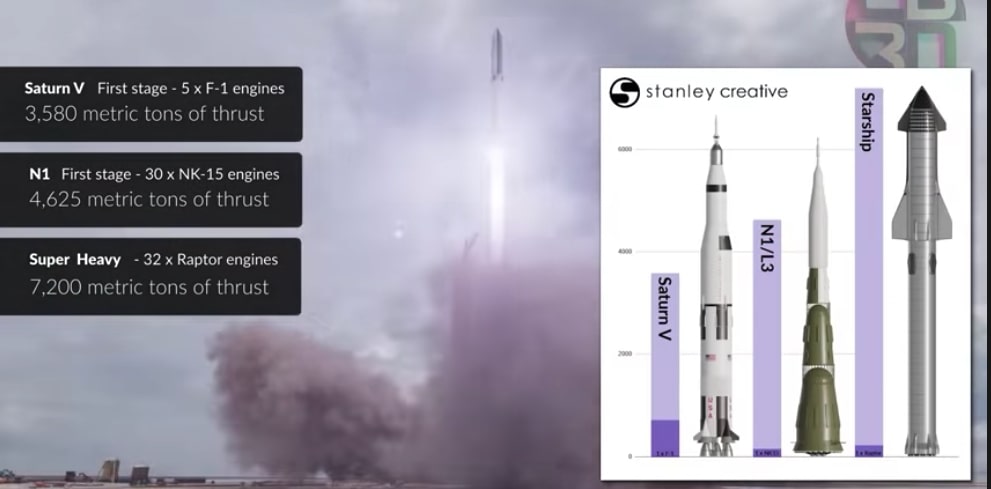Starship Rocket vs Saturn 5

In the realm of space exploration, two monumental giants stand as testaments to human ingenuity and ambition: the Starship Rocket and the Saturn V. These titans represent pivotal milestones in our journey beyond Earth’s confines, each embodying the pinnacle of technological achievement of its era. As we delve into the intricacies of these marvels, we uncover not just the evolution of spacefaring technology but also the boundless human spirit that propels us ever further into the cosmos.
The Saturn V: Pioneer of Space Exploration:
First taking flight in the 1960s, the Saturn V rocket remains a symbol of NASA’s Apollo program and mankind’s first steps on the lunar surface. Standing at a towering 363 feet, the Saturn V was a marvel of engineering, comprised of three stages designed to deliver payloads beyond Earth’s orbit. Its colossal size and immense power propelled it to the forefront of space exploration, carrying astronauts on historic missions such as Apollo 11, the first manned lunar landing.
The Saturn V boasted unmatched thrust, with its five F-1 engines generating a staggering 7.5 million pounds of thrust at liftoff. This unprecedented power enabled it to carry payloads of up to 260,000 pounds into low Earth orbit and 107,000 pounds on a trajectory to the Moon. With its flawless track record, the Saturn V cemented its place in history as the vehicle that transported humanity to new frontiers, inspiring generations to dream of reaching for the stars.
The Starship Rocket: Redefining Space Travel:
Fast forward to the 21st century, and SpaceX’s Starship Rocket emerges as a paradigm-shifting force in space exploration. Designed with the vision of enabling humanity’s expansion beyond Earth, the Starship represents a radical departure from traditional rocketry, incorporating cutting-edge technologies and innovative design principles.
At a towering height of 394 feet, the Starship surpasses even the Saturn V in size, marking a new era of super heavy-lift launch vehicles. What sets the Starship apart is its fully reusable architecture, a feat previously deemed unattainable in the aerospace industry. By employing advanced materials such as stainless steel and leveraging propellant production on Mars, SpaceX aims to drastically reduce the cost of space travel and pave the way for sustained human presence on other celestial bodies.
The Starship’s Raptor engines, powered by liquid oxygen and methane, promise unmatched efficiency and versatility. With a projected thrust of over 16 million pounds at liftoff, the Starship is poised to carry payloads of up to 220,000 pounds to low Earth orbit and beyond. Moreover, its modular design enables rapid reusability and adaptability for various mission profiles, from crewed missions to Mars to satellite deployment and beyond.
Comparative Analysis: Starship vs. Saturn V:
While both the Starship and the Saturn V represent monumental achievements in space exploration, they differ significantly in design, capabilities, and intended missions.
- Reusability: One of the most striking distinctions between the two rockets is their approach to reusability. While the Saturn V was a disposable launch vehicle, with each stage discarded after use, the Starship is designed for full reusability, significantly reducing the cost of access to space and enabling rapid turnaround between missions.
- Payload Capacity: In terms of payload capacity, the Saturn V holds the edge in absolute terms, with its capability to launch heavier payloads to the Moon. However, the Starship’s versatility and reusable design make it a formidable contender, particularly for sustained missions beyond Earth’s orbit.
- Propulsion Technology: The propulsion systems of the two rockets also differ fundamentally. The Saturn V relied on the powerful but less efficient kerosene-fueled F-1 engines, whereas the Starship employs the highly efficient and scalable Raptor engines, powered by liquid oxygen and methane.
- Mission Profiles: While the Saturn V was primarily designed for lunar missions within NASA’s Apollo program, the Starship is envisioned as a multi-purpose spacecraft capable of missions ranging from crewed exploration of Mars to satellite deployment, lunar landings, and beyond.
Conclusion:
In the ongoing saga of human space exploration, the Starship Rocket and the Saturn V stand as monumental achievements, each representing the apex of technological prowess of its respective era. While the Saturn V paved the way for humanity’s first steps beyond Earth, the Starship heralds a new age of space travel, characterized by reusability, efficiency, and the promise of interplanetary colonization.
As we gaze toward the heavens, propelled by the legacy of the past and the vision of the future, the rivalry between these titans of space exploration fades into insignificance against the backdrop of our collective journey to the stars. Whether it be the towering inferno of the Saturn V or the sleek silhouette of the Starship, one thing remains abundantly clear: the human spirit knows no bounds in its quest to explore the cosmos and unlock the mysteries of the universe.






